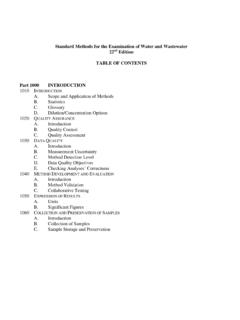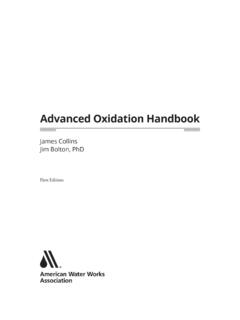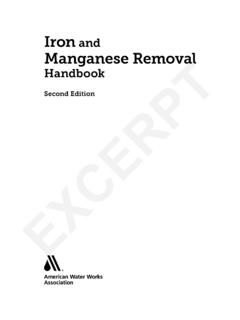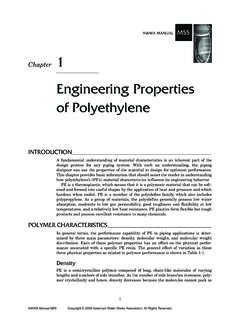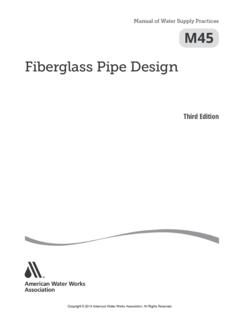Transcription of Selecting and Sizing Water-Storage Tanks
1 57AW WA M A N U A LM42 Chapter5 Selecting and Sizing Water-Storage Tanks The selection and Sizing of a Water-Storage tank involve a number of engineer-ing considerations and generally require a detailed analysis of water demands, sup-ply sources, and the distribution system. The purpose of this chapter is to discuss these design parameters and factors to consider in Selecting and Sizing a steel tank. A detailed treatment of each factor has not been attempted. PEAK DEMAND _____Peak demand is usually the first factor to consider when Sizing a distribution system tank. Most water supply sources are best operated on a 24-hour production basis and produce a quantity of water in 24 hours that is equal to the 24-hour demand.
2 Although clearwells offer a cushion between production and demand, clearwell capacity is usually considered production reserve rather than distribution reserve. If distribution system supply sources are operated with a relatively constant pumping rate equal to the daily demand rate, any water in excess of the hourly demand must be stored in elevated Tanks (whether the elevation is natural or structural). The usual curves for demand are lowest in the early morning hours, and the Tanks are filled during this period. As the day progresses, demand increases and usually peaks in late afternoon; the Tanks feed back into the system during this period. A tank functioning in this manner helps maintain a relatively constant pressure in the system.
3 Figure 5-1 shows a typical daily demand curve. In this example, the maximum consumption rate is 200 percent of the average daily rate, and the quantity stored to achieve a level pumping rate is 20 percent of the daily consumption. This 20 percent of daily consumption is not necessarily the optimal ratio of storage to consumption, because most water regulatory agencies require more storage or emergency sources. Copyright 2013 American water Works Association. All Rights Reserved. 58 STEEL Water-Storage TANKSFIRE FLOW _____Fire flow is usually the second factor to consider when determining tank capacity. Insurance underwriters have developed formulas to determine desirable quantities, pressures, and flow duration.
4 Using these formulas, all classes and uses of all buildings within the area served are considered. Frequently, storage requirements for fire flow are greater than the storage required for system regulation, and a large fire-flow demand may require additional pumping capacity as well as the use of stored water . TOP AND BOTTOM CAPACITY LEVELS _____In addition to establishing the storage facility s necessary capacity, required top and bottom capacity levels must also be established. These three values, combined with aesthetic and economic considerations, greatly influence the geometry of the final tank design. A detailed hydraulic analysis of the water distribution system for which the storage tank is being designed is usually conducted to establish the BCL and TCL elevations that will provide effective, functional storage at a given tank site.
5 A distribution system is analyzed by creating a computer model with hydraulic data for the pipeline distribution network, distribution system pumping facilities, and various water demand conditions. This program produces hydraulic gradients across the distribution system for the particular demand condition represented ( , fire flow, maximum hour, maximum day, tank replenishment). The goals of this exercise are (1) to produce a coordinated design covering system pumping capacity, head conditions, and pipeline improvements necessary to provide adequate system trans- mission capacity to and from the tank, and (2) to establish the range of operating gradients or water levels at the tank.
6 For further information, refer to AWWA Manual M31, Distribution System Requirements for Fire Protection, and AWWA Manual M32, Computer modeling of water Distribution Systems. water quality ISSUES_____ The design phase of a new tank project is the best time to consider how a tank design and piping configuration may contribute to water quality . water circulation and water flow should be included in the design parameters. water age can be managed through a well-designed system that exercises the tank; considerations include water turn-over, altitude valves, pumping management, and other components for maintaining fresh water in the tank and mitigating water quality issues. Both active and passive systems for improving water quality in Tanks are available for new and existing quality is a significant concern to water distribution system managers.
7 Disinfection by-product (DBP) formation is largely dependent on reaction time, and it can continue for several days within the distribution system. At the same time, disinfectant residual must be maintained throughout the most remote components of the system to ensure pathogen-free water . Managing the residence time of water within storage Tanks is one practice available to minimize water age within the dis-tribution system. water system managers and engineers should consider the need for circulation of water and residence time management within storage Tanks during the design 2013 American water Works Association. All Rights Reserved. Selecting AND Sizing Water-Storage Tanks 59 Demand Rate12:00 Midnight12:00 Midnight6:00 PM12:00 Noon6:00 AMFillingTanksFillingTanksDrawing From TanksConstant PumpingRate to EqualDaily DemandDemandCurveFire FlowHour of DayFigure 5-1 Typical daily flow at constant pumping rate ENERGY COSTS _____Many power utilities have adopted rates based on when electricity is used, and it may be cost-effective to control pumping in an effort to reduce the maximum power demand.
8 Figure 5-1 shows the use of constant-rate pumping for 24 hours. However, the part-time use of more or larger pumps may be more cost-effective. To get the best electric power rates, pumping (or power-demand load) must be reduced during the periods when the maximum electrical demand occurs. A simple way to reduce rates is to pump more water into the storage Tanks during hours when electrical power demand is low and to reduce pumping during periods when that demand is high (Figure 5-2). This technique requires increased storage capacity. FUTURE NEEDS _____Future needs are an important consideration, and where practical, a tank should be sized to provide for anticipated future growth and the resulting increase in water demands.
9 This consideration is particularly important in the design of Water-Storage Tanks , since they represent a large capital investment, and future enlargement of their storage capacity is not always feasible. Proper Sizing of a storage tank must also establish proper water turnover and circulation to ensure that water quality standards are met. Demand Rate12:00 Midnight12:00 Midnight6:00 PM12:00 Noon6:00 AMFillingTanksFillingTanksDrawingFromTan ksPumpingRateDemandCurveFire FlowHour of DayFigure 5-2 Typical daily flow with variable- rate pumping Copyright 2013 American water Works Association. All Rights Reserved. 60 STEEL Water-Storage TANKSENVIRONMENTAL IMPACT _____ The major environmental impact of the tank itself is its appearance.
10 This impact can be mitigated by the use of tank designs and exterior coating systems that blend into the surrounding terrain. Site location and site development (discussed in detail in chapter 6) are also important factors to consider in reducing any adverse environmen- tal impacts. The increased availability of water for use by customers made possible by greater storage may also be an environmental concern, but this consideration relates to the broader topics of land-use planning and wastewater discharge capacity, which should be evaluated before the need for additional storage is addressed. TANK COSTS _____ Tank costs vary with type, capacity, and site. These factors are interrelated and are discussed in the following paragraphs.

